Homemade at war
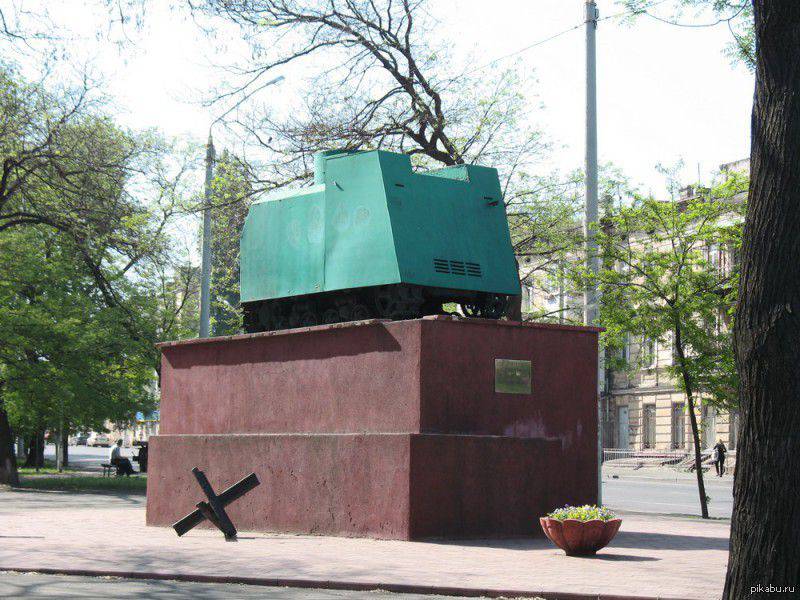
In any war, each fighting side tries to inflict maximum damage on its opponents, using all available means for this, while at the same time experiencing a natural desire to survive. When such means are not available, or are sorely lacking, ingenuity comes to the aid of the fighting forces, often embodied in bold technical solutions. AT stories There are many cases of wars when artisanal “machine guns”, improvised artillery systems, combat vehicles assembled literally on the “knee” and other engineering and technical wonders of front-line “self-made” made a significant contribution to the course of individual battles, battles and even campaigns. Particularly great was the temptation to rework purely civilian vehicles into something deadly, including ordinary rural workers — tractors into combat vehicles.
A tank is quite expensive. Armor, weapons, a running gear, an engine, various equipment needed, such as sights, crew training, in the end, are worth a lot of money, so purely commercial interests, as well as an irrepressible flight of human imagination, generated original various projects for transforming the tractor fleet into tank. I must say that this technique has been used for a long time, back in the years of the First World War and in the 20-30s, various types of “combat” vehicles, as well as “simulators” of tanks were developed on the basis of agricultural tractors, tractors, bulldozers. For example, in the 20s in the Lipetsk Tank School, prototypes of tanks received from Germany, quite summing up, were called "grasstractors".
During World War II, an extensive range of such "technical innovations" based on tractors and tractor units produced almost all the belligerents, including various irregular units. Many of these machines were mass-produced, having a solid industrial base, but this article will focus on handicraft and semi-handicraft combat armored vehicles assembled from nothing and out of the blue.
Tank "On fright".
The most famous and famous of these surrogates, described in more detail in Russian historiography, was the Odessa Tank, better known under the name NI-1 ("On Fright") - produced during the defense of Odessa in 1941 and which is an ordinary STZ caterpillar tractor -5 (NATI), sheathed with steel sheets. The troops of the Primorsky Army, the Marine Corps of the Black Sea fleet, defending the city, experienced a serious shortage of weapons and military equipment, so it was decided to convert the existing tracked tractors, of which more than 100 units were in Odessa by the time the siege began, into light-armed armored cars or tanks. The tank project was developed by the chief engineer of the plant. January uprising (colloquially “Proletarka”) P. K. Romanov, A. I. Obednikov and captain U. G. Kogan.
A pilot copy of an armored tractor on the STZ-5 chassis, with the on-board inscription “Death to Fascism”, was built by 20 August 1941, and during the week two more cars were produced, called “Chernomor” and “Proletarian”. The reservation was not carried out as such - the besieged city simply did not have the necessary amount of armor plates, therefore a welded hull was mounted on the tractor chassis, which was assembled from sheets of boiler-house and shipboard cladding steel capable of withstanding hitting rifle bullets at a distance of 100 meters. The layout of the improvised tank did not differ in the originality of the solution. In front of the housed the engine compartment, behind which there was a fighting compartment. The driver was located in the middle of the car and had a single viewing slot for a forward view. On the roof of an armored tractor, a tower was usually installed, sometimes taken from padded light tanks, but most often used towers of its own design, manufactured for specific weapons. It was installed 7,62-mm machine gun DT or 12,7-mm machine gun DShK. There are reports of an attempt to install a tank 45-mm gun and even a mountain 20-mm cannon on a combat vehicle, but according to eyewitnesses, it turned out that most of the guns or NI guns shown in the rare photographs that have come down to us were just a fake game designed crush the enemy's morale.
This is what is said about the production process of these unusual cars in the "Report on the Defense of Odessa", written after the evacuation of troops from the city: "In the middle of August, equipment for tanks and armored cars from tractors and trucks was organized at the plants of the January Uprising and the October Revolution. The tanks were covered with 14-20 millimeters shipbuilding steel armor. Wooden bars were laid between the armor and the inner lining. By September 14 an 31 machine was made, which made it possible to form a tank battalion. n. 14 September 15 start booking more tractors ... "
According to various sources, the total number of tractors converted in this way for the entire period of Odessa’s defense was about 60 units.
Very little is known about the combat use of "tank-tractors", as they were called in official documents, and this information is sometimes contradictory. One of the detailed documented episodes of the combat use of armored tractors was the operation to defeat the Romanian troops in the Eastern sector of the Odessa Defensive Area (OOR) 21-24 of September 1941. Self-made combat vehicles led a successful offensive as part of the 157 rifle division. The appearance of armored vehicles in the battle formations of the troops had a positive impact on the course of the operation. For example, several NI tanks that came to the aid of the 1330 regiment of the 421 division at the very moment when the offensive was almost choked turned the tide of battle and helped the bloodless units to dislodge the enemy from a strategic height. The madcap attacks of the horribly roaring iron monsters, especially at night, did have a demoralizing effect on the Romanian soldiers, who did not expect a massive use of tanks and did not have enough anti-tank weapons.
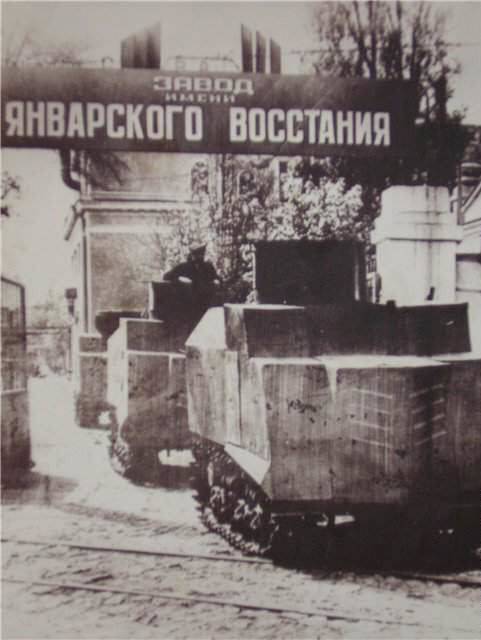
Fig. No tanks out of the factory gates. Shot from the film of the Odessa film studio "Train to distant August"
The hour of triumph in the short combat career of homemade crafts in Odessa came 2 October 1941. A company of “Odessa tanks”, during the offensive of the southern sector of the OOR under the Dalnik, was put into combat as part of the 35-based 210 tank battalion, supported by the tank company 141 of the Kuban division reconnaissance, which had 15 BT-7 tanks. When such a large number of Soviet machines appeared, the Romanian 8 machine-gun battalion in panic threw down the positions and fled, dragging the neighboring 36 machine-gun battalion of the 2 regiment of the Romanian border division. The Romanian command was able to stop the battered battalions only near the village of Chervonyi Raseselyan, a few kilometers from the front line. Soviet tanks rushed into Lenintal and transported serviceable guns with a set of shells abandoned by the Romanians on the 24 trailer.
The fate of the unusual combat vehicles is unknown. There is fragmentary information that the surviving armored tractors covering the evacuation of the Soviet troops, who were forced to remain in Odessa, were flooded into the sea. Some of them as trophies, went to the German-Romanian units. Not a single car survived to this day, even those two NI tanks standing on pedestals in the now independent Ukraine are a replica made for the next anniversary of the Victory in the Great Patriotic War .. There are also very few photographs of the legendary armored tractor, in particular, which bypassed more than one edition of the picture, with three machines leaving the factory gates, nothing more than a freeze-frame from the wonderful film of the Odessa film studio “Train to distant August” directed by V. Lysenko, released on the country's screens in 1971 year.
In the various works devoted to the defense of the hero-city, especially in the Internet editions, many myths have been created around the legendary tank, there is also an opinion about the complete, apart from NO, the absence of Soviet troops from the OOR armored vehicles in general. However, this is not quite true: at the time of the Romanian troops’s approach to the city, the Primorsk army had 6 operational BT tanks, and their number increased significantly in the future. His Majesty case intervened in the case. At the end of July at st. Separate several echelons with defective and damaged tanks in Moldova in the battles of the 2-th mechanized corps were found, and in the Marinovo junction there was another echelon with tanks that were accompanied by tank crews following the damaged equipment to the repair site. The defenders of Odessa managed to remove the trains from under the very nose of the enemy, and by August 9 platforms with tanks arrived safely in the city.
At the plant them. A tank repair workshop was organized by the January Uprising and by mid-September 1941 from the machines that had left the workshops, the formation of the 210 Army Tank Battalion under the command of Senior Lieutenant N. Yudin, which received various tanks, with a total of 35 units, was completed. In total, during the heroic defense, Odessa workers were able to commission the 42 tank BT-5 and BT-7. There is reliable information that with the troops of the Tiraspol fortified area, which had a NUMX-thousandth garrison, an incomplete company of obsolete, but underwent deep modernization at the end of the 11’s MS-30 (T-1) tanks, retreated to Odessa, which also joined the armored fist of the Maritime Army . Also in the city along with military units arriving to replenish the garrison, delivered their full-time armored vehicles, as was the case with the 18-th Kuban division.
That was, that was, however, the heroism of the Soviet tankers, who were marching into battle, and on real tanks and on angular, clumsy NO, does not diminish at all.
Moonsund "tanks"
The fighting on the Moonsund Islands in the Baltic Sea Ezel (Saaremaa), Dago (Hiiumaa), Mone (Muhumaa) and Vormsi from September 6 to October 22 1941, a lot of publications are devoted to both domestic and foreign literature. One day I came across a picture of five people in civilian clothes and three servicemen standing near a strange kind of car on tracks.
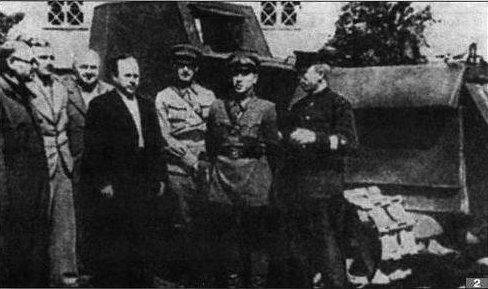
The caption read: “An armored tractor built in the workshops of the Kuressary School, September 1941 of the year.” I couldn’t find any materials on this product for a long time, until I came across an article from the magazine “Tankomaster” No. 5 for the 2001 year, which gave some answers to questions on this topic. Where did such combat vehicles on the islands, cut off by the advancing German troops from the bases on the territory of the Soviet Baltic, come from?
Contrary to popular belief in various publications on this topic, which refers to the complete absence of Soviet troops in Moonsund armored vehicles, it should be noted that there were tanks on the islands. By the beginning of the battle for the archipelago, the garrison of the largest island of the Ezel archipelago included a company of chemical (flame-throwing) tanks of the Baltic Sea Coastal Defense (BOBR) of the Baltic Fleet and several different unidentified armored units belonging to units deployed in the archipelago. Immediately in combat, improvised, improvised tanks, made in quantities of several pieces, were taken at the machine shops on the islands of Saarem and Dago. So in the “Summary of the Battle of the Red Banner Baltic Fleet from 22.06 to 31.12.1941” there is a record that “in order to strengthen the fire defense, defenders of Ezel. on their own initiative, they built an 4 tank (from tractors) armed with machine guns ... ”.
After the war, the “Ezelian tanks” was recalled by a resident of Fr. Saarema A. Klaas. Here is what he writes: “... a tank tractor was built at the Kuressaar Vocational School under the guidance of the masters Helga and Ojasauna. The basis of the tank was a tractor type NATI, instead of the cab and the hood was made impenetrable for bullets superstructure. It was experimentally established that the 1941 mm steel sheet, even when doubled or tripled, does not protect against a rifle bullet. Then the master chose this method: between the two steel sheets left a gap in 6 - 3 centimeters and poured it with cement. These plates were protected even from armor-piercing bullets. The entire superstructure of the tank was welded from flat pieces of the slab, since in the conditions of the school it was impossible to bend the slabs. It was not possible to make a rotating turret - it was necessary to make a hole on each side of the turret for firing, from which it was possible to stick out the barrel of a rifle or light machine gun. In the tank could fit three. In total, three such tanks were built in the Kuressaar handicraft school. ” “Billem Estori, Pavel Helk, Sergey Kask, Mihkel Meremza showed particular energy in their production,” writes another Estonian author in the book “Collection of Memories of Participants in the Defense of Tallinn and the Moonsund Archipelago”, most likely these people are depicted in the above image.
Then A.Klaas tells about the combat use of one of these improvised armored vehicles in the same memoirs: “In the evening of September 18, I received an order with two sailors sent from the commandant's office to go to the town's vocational school (Kuressare) and deliver a tank from there. According to the order, we overtook the tank in Tori and set it under large trees near the former hospital building. Here our tank was disguised and at the same time we could keep both bridges under fire. For two days we guarded the bridges with the machine gunner. 20 September I was called to the commandant's office. We boarded the car and drove off in the direction of Syrey. Our tank also moved there. Later we saw him in Mandyala. Apparently, with his help, our units kept the plain between Mandyala and Nasva under fire. ”October 5 The organized resistance of the Soviet troops on Ezel 1941 was over. In the German communique on the results of the battles on the largest island of the Moonsundoto archipelago, it was said about the seizure of numerous X-NUMX tanks and armored vehicles among the numerous trophies. It is not clear what technology was discussed, perhaps it was a miracle that survived the battle of Orissaar HT’s chemical tank guns, homemade Kuressaarsky craftsmen or lightly semi-armored tractors of the K-Komsomolets type used by the defenders of the island as light machine gun tankettes and recorded by the Germans "in the tanks."
On the island of Dago, the production of armored tractors began on August 28 1941, by order of the North Fortified Sector Command (SLU) of Colonel A. Konstantinov, who ordered the 3 Battalion of the 167 Infantry Regiment to Captain MK Andreev: “Issue for tanks 2-machine-gun, give political officer 1 company 156 cn. Consequently, the “father” of the “Dagan tanks” was the military commissar of the 1 Company of the 1 Battalion of the 156 Rifle Regiment, political instructor PP Prokhorov. Subsequently, the commander of this battalion, Major A. B. Stolyarov, recalled this armored unit as follows: “The headquarters of the SLA allocated a tractor at our disposal. We have sheathed it with three millimeter sheets of iron. Car tires were laid between the double walls of the skin - to enhance the improvised armor. A machine gun was installed on top of it, and we had an armored tractor that could easily maneuver and was not afraid of rifle-fire ... ”. In the miraculously preserved “Report on the combat operations of the SESa BBBR CBF” on the Soviet tanks on Dago there are the following lines: “... It was begun to adapt two tractors for armored vehicles. The tractors were covered with 20 mm iron and two machine guns were mounted on them. Note: The fighting showed that at the beginning of the action the bullets did not pierce the armor, but later both were put out of action by armor-piercing bullets. ”
Other entries in the documents about the use of home-made belong to October 12 1941 - the day of the landing of the Germans on Hiiumaa and the beginning of the 10-day heroic defense of the island. The historical evidence mentions the participation of two units of unidentified armored vehicles in the area of Lyudia in the battles, together with the 3 battalion of the 167 rifle regiment. In the future, the same battalion was engaged against the German assault force that landed near the village of Nurste where it was "reinforced by the 1 wedge and armored vehicle (made by ourselves)." It can be assumed that the available armored vehicles Dago defenders used in the all-day October 16 heavy defensive battles in the area of the town Nymba. It’s not for nothing that the Germans used the 14 th anti-tank company (highlighted by me) of the 176 th Infantry Regiment of the 61 Division, and the commander of this company, Lieutenant Schlüger, was killed during a regular Soviet counterattack. which it was possible and took part last "Dagos tanks".
The exact number of armored tractors manufactured at Moonsund can no longer be accurately named by anyone; the same Strelbitsky calls the number in 5-6 units. Nevertheless, these primitive machines were another handful of sand, which successfully fell into the glittering bearings of a debugged blitzkrieg.
Reservation of tractors was made not only in Odessa and on the Moonsund Islands. Production of ersatz tanks was established in Leningrad at the Izhora plant, there is practically no data on these machines. Only in front-line reports, it is reported that on 5 August 1941, the 2 Infantry Division of the People’s Militia had two T-26, five BA-10, two KV-2 and five "IZ medium tanks". What kind of products they were, what they looked like and how their combat path was formed is unknown.
"Wunderwaffe" by Major Becker
At the zenith of the Wehrmacht victories on all fronts, the Germans did not need to rework purely peaceful vehicles into combat. However, by the end of the XXNX of the year, in the Reich industry’s shortage of everything and everything, the gloomy Teutonic genius offered a lot of original engineering solutions and issued a lot of unusual combat units “on the mountain”. Having in the arsenals an abundance of all kinds of samples of captured equipment collected throughout Europe, the German engineers successfully managed to force her to fight against the former owners. The overwhelming majority of improvised combat vehicles were mass-produced at factories and only in some cases from need or thanks to the energy and quickness of certain people, handicraft and semi-handicraft homemade products poured into the battle formations of the fighting German troops. Under the conditions of the Eastern Front, which was rapidly advancing towards the borders of Germany, the Germans simply had no time to engage in “inventive” activities; moreover, in Russia there was no suitable material base for this.
The situation was completely different in the West, with its developed industry and infrastructure. In France, before the day “D”, no active hostilities were conducted, which allowed the High Command of the Wehrmacht to “sequester” the divisions standing there, especially getting to the tank fleet: it was necessary to fill the gaping gaps in the pancervised movements on the Eastern Front with something! July 6 Anglo-American troops landed in Normandy and began a successful advance inland. In the Kann region, the Allied forces met with serious resistance from the 21 Panzer Division under the command of General Feuchtinger. 18 July 1944, near the village of Kanyi 3, the battalion of the Royal 29 Tank Regiment of the armored brigade 11 of the Allied armored division ran into unexpectedly strong resistance from the German forces.
This is how the battle commander Major Close describes this battle in his book: "The History of the Third Royal Tank Battalion in World War II" published in London in 1998: "We made a warning to the Guards Armored Division that was passing by Kanyi behind us, despite this they continued to move and in seconds lost 20 tanks. We saw how an advanced regiment tried to circumvent the firing point in Kanyi. In the process, they lost several more tanks, this time from fire from the forest to the east. ”
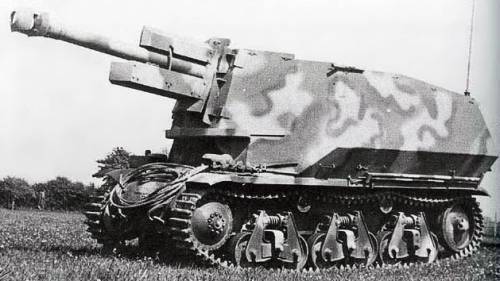
Fig. Becker self-propelled howitzer
One of the officers of the German 21 Tank Division was the commander of the 152 Tank-Grenadier Regiment, Major Hans von Luck, whose divisions held defenses in the area of this settlement. Von Luke in 1998 wrote a rather informative book, “At the Edge of a Tank Wedge,” in which the battle at the town of Cagny described as follows: “For the next few hours, everything depended on the battery in Cagny. I got into my tank and, being careful, went to the village. Leaving the tank at the church, I ran to the four guns, and there my eyes opened an incredible spectacle: 8,8-see guns fired volley after volley. Shells flew through the eared field like torpedoes. The attendants at the guns were proud of how she made her debut as an anti-tank unit. All four guns were safe and sound - no one attacked them. On the vast fields north of the village stood at least 40 British tanks, some were burning, some were not. I saw how the tanks, which had already crossed the main road, slowly began to roll back. Becker’s assault guns also joined the battle. From the right flank they beat down any tank that attempted to bypass the village. ”
What kind of cars and where did these “Sturmgesheswagen” come from on this site, as it turned out at the right time? And who is this Becker? About this man in domestic historical research has not written almost nothing, at least, it was not possible to find any details about the life and combat path of this officer. It is authentically known that he came from an aristocratic family of German industrialists and was entrusted to the highest circles of the Third Reich, besides, this man was a very talented engineer. At the beginning of the 1944 of the year, Becker, on personal initiative and with his own hand-made drawings, started a rebuilding of the chassis from old French tanks into various SPGs by his “building team” (Baukommando Becker). Using his extensive connections, the energetic Major managed to get the tools and sheet armor, which he successfully used to translate his ideas. Released combat vehicles did not look very attractive, however, as practice has shown, they proved to be formidable on the battlefield weapons.
A little background. Having completed the war with France in 1940, the Germans, in addition to moral satisfaction, also received a considerable number of trophies, including, among other things, a fairly large number of H-35 and H-39 tanks and components. For a long time they were gathering dust in warehouses, however, in the light of the total lack of equipment at the beginning of 1944, they also remembered this property. More precisely, I remembered that Major Becker, about the possibility of using these chassis to create different ACS.
There were two types of vehicles in the Alfred Becker repair shops owned by him: a light self-propelled howitzer and an anti-tank SAU. On the upper part of the hull, an angular, open top cabin was installed, the side sheets of which had small angles of inclination, and in the frontal part there was a cut-out for installing the required implement. The self-propelled howitzer, in addition to its direct purpose: the fight against infantry and field fortifications, could effectively hit tanks, for which the ammunition had armor-piercing tracer and cumulative projectiles. According to various sources, the entire 12 ACS 10,5cm was built. leFH 16 auf Geschutzwagen, and 8 anti-tank SAU 7.5cm Pak40 auf PzKpfw (f) "Marder I (SdKfz 135)".
The main disadvantage of these self-propelled guns was the weak armor and the extremely low mobility that came to her from its progenitors H-35 and H-39. As mentioned above, all of Becker’s “self-propelled guns” entered into the 2 battalion of the 152 battalion of the tank-grenadier regiment and played a decisive role in the battle of Kanyi, stopping the Anglo-American offensive in this sector for several days.
Battle Tractors Resistance
In the year 1940, France, which was brought to its knees, was divided into two parts. North was occupied by German troops, in the south, under the tinsel of independence, the power of the puppet government of Vichy was established. The overwhelming majority of the population of the metropolis reacted to such a “reform” of their country neutral positively and took everything quite calmly.
The emerged resistance movement in the initial period of German rule was not massive and was not one hundred percent French Communist, as Soviet historians had previously claimed. For the most part, it was run by a few English agents, abandoned in various ways into the occupied territory of the Third Republic. Only since the summer of 1944, when the building of the Millennial Reich staggered under the blows of the Allied forces, the almost universal French “collaborator” miraculously transformed into the same all-encompassing “resistance”. The newly appeared rebels immediately raised the question of military equipment, essential for the speedy expulsion of the "damned boshey."
Some of the vehicles were received by the Resistance fighters from the Allies, some were taken as trophies taken from the retreating invaders, but a fair amount of lightly armored vehicles were made by them independently. At the factory in the town of Bagne de Biggo (Bagn; res de Biggor), located in the south of the country at the foot of the Pyrenees Mountains, even before the war, the release of a tracked artillery tractor Lorraine 37L was organized. The Germans, after the defeat of France, left production to the Vichy government, only they began to make this car as an unarmored trelevochny and agricultural tractor, that is, an unarmored national-made tractor was made of an armored arttyagach.
It should be noted that the military industry of the Reich readily used the chassis produced at this plant for the manufacture of ACS Marder I on their base. The French somehow managed to save the armor plates left over from the pre-war production, and at the first opportunity, immediately returned the former military purpose to the former trailer.
Production of the "partisan tank" was launched in August 1944 of the year. The new-found fighting machine was a newly booked tractor, equipped with a makeshift armored vehicle with a Hotchkiss M1914 machine gun. On the first day, three such wedges were made.
However, the combat effectiveness of the product left much to be desired, so the partisan masters developed another model, with more serious armor and weapons. An additional shield of armor plates was installed on the same long-suffering Lorraine, they made a tall battle cabin, in which they placed the trophy 20 mm "mitrailleuse de aviation" MG 151 / 20. The crew consisted of three people.
On the use of this technique in battle there are scattered and contradictory data. It is known from foreign sources that several such tanket shoes were used by French soldiers in Southern France against the Italian-fascist troops of the Republic of Salo in the deep autumn of 1944. Production of the "partisan tank" was discontinued on January 15, 1945. In total, these unusual combat vehicles, which joined the army of the French resistance, were made around 50 units: 20 in a machine-gun variant and 30-35 units with an air gun.
The author thanks K.B. Strelbitsky for kindly provided materials.
- Pomeranian
- From the Internet and the personal collection of KB Strelbitsky
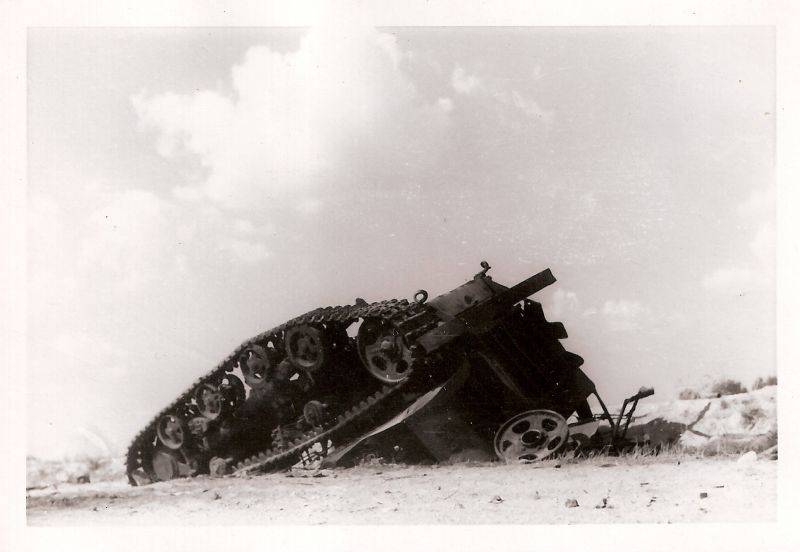
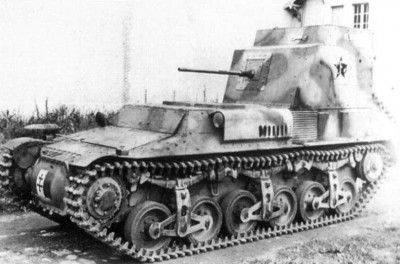
Information